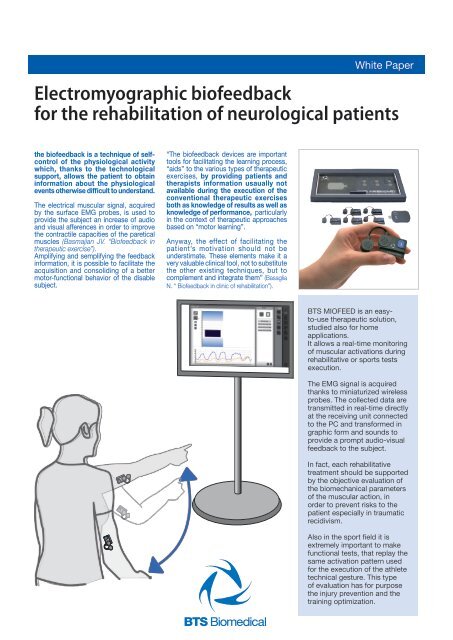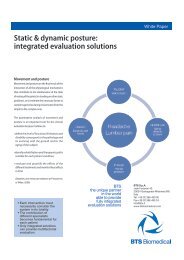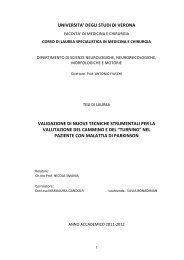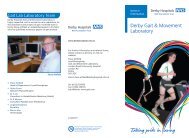Electromyographic biofeedback for the rehabilitation of ... - Bts.it
Electromyographic biofeedback for the rehabilitation of ... - Bts.it
Electromyographic biofeedback for the rehabilitation of ... - Bts.it
Create successful ePaper yourself
Turn your PDF publications into a flip-book with our unique Google optimized e-Paper software.
Wh<strong>it</strong>e PaperWh<strong>it</strong>e Paper<strong>Electromyographic</strong> <strong>bi<strong>of</strong>eedback</strong><strong>for</strong> <strong>the</strong> <strong>rehabil<strong>it</strong>ation</strong> <strong>of</strong> neurological patients<strong>the</strong> <strong>bi<strong>of</strong>eedback</strong> is a technique <strong>of</strong> selfcontrol<strong>of</strong> <strong>the</strong> physiological activ<strong>it</strong>ywhich, thanks to <strong>the</strong> technologicalsupport, allows <strong>the</strong> patient to obtainin<strong>for</strong>mation about <strong>the</strong> physiologicalevents o<strong>the</strong>rwise difficult to understand.The electrical muscular signal, acquiredby <strong>the</strong> surface EMG probes, is used toprovide <strong>the</strong> subject an increase <strong>of</strong> audioand visual afferences in order to improve<strong>the</strong> contractile capac<strong>it</strong>ies <strong>of</strong> <strong>the</strong> pareticalmuscles (Basmajian JV. “Bi<strong>of</strong>eedback in<strong>the</strong>rapeutic exercise”).Amplifying and semplifying <strong>the</strong> feedbackin<strong>for</strong>mation, <strong>it</strong> is possible to facil<strong>it</strong>ate <strong>the</strong>acquis<strong>it</strong>ion and consoliding <strong>of</strong> a bettermotor-functional behavior <strong>of</strong> <strong>the</strong> disablesubject.“The <strong>bi<strong>of</strong>eedback</strong> devices are importanttools <strong>for</strong> facil<strong>it</strong>ating <strong>the</strong> learning process,“aids” to <strong>the</strong> various types <strong>of</strong> <strong>the</strong>rapeuticexercises, by providing patients and<strong>the</strong>rapists in<strong>for</strong>mation usaually notavailable during <strong>the</strong> execution <strong>of</strong> <strong>the</strong>conventional <strong>the</strong>rapeutic exercisesboth as knowledge <strong>of</strong> results as well asknowledge <strong>of</strong> per<strong>for</strong>mance, particularlyin <strong>the</strong> context <strong>of</strong> <strong>the</strong>rapeutic approachesbased on “motor learning”.Anyway, <strong>the</strong> effect <strong>of</strong> facil<strong>it</strong>ating <strong>the</strong>patient’s motivation should not beunderstimate. These elements make <strong>it</strong> avery valuable clinical tool, not to subst<strong>it</strong>ute<strong>the</strong> o<strong>the</strong>r existing techniques, but tocomplement and integrate <strong>the</strong>m” (BasagliaN. “ Bi<strong>of</strong>eedback in clinic <strong>of</strong> <strong>rehabil<strong>it</strong>ation</strong>”).BTS MIOFEED is an easyto-use<strong>the</strong>rapeutic solution,studied also <strong>for</strong> homeapplications.It allows a real-time mon<strong>it</strong>oring<strong>of</strong> muscular activations duringrehabil<strong>it</strong>ative or sports testsexecution.The EMG signal is acquiredthanks to miniaturized wirelessprobes. The collected data aretransm<strong>it</strong>ted in real-time directlyat <strong>the</strong> receiving un<strong>it</strong> connectedto <strong>the</strong> PC and trans<strong>for</strong>med ingraphic <strong>for</strong>m and sounds toprovide a prompt audio-visualfeedback to <strong>the</strong> subject.In fact, each rehabil<strong>it</strong>ativetreatment should be supportedby <strong>the</strong> objective evaluation <strong>of</strong><strong>the</strong> biomechanical parameters<strong>of</strong> <strong>the</strong> muscular action, inorder to prevent risks to <strong>the</strong>patient especially in traumaticrecidivism.Also in <strong>the</strong> sport field <strong>it</strong> isextremely important to makefunctional tests, that replay <strong>the</strong>same activation pattern used<strong>for</strong> <strong>the</strong> execution <strong>of</strong> <strong>the</strong> athletetechnical gesture. This type<strong>of</strong> evaluation has <strong>for</strong> purpose<strong>the</strong> injury prevention and <strong>the</strong>training optimization.
Wh<strong>it</strong>e Paper<strong>Electromyographic</strong> <strong>bi<strong>of</strong>eedback</strong><strong>for</strong> <strong>the</strong> <strong>rehabil<strong>it</strong>ation</strong> <strong>of</strong> neurological patientsFunctional <strong>rehabil<strong>it</strong>ation</strong>During <strong>the</strong> multiple phases <strong>of</strong> <strong>the</strong><strong>rehabil<strong>it</strong>ation</strong> program, BTS MIOFEEDthrough <strong>the</strong> <strong>bi<strong>of</strong>eedback</strong> function,allows <strong>the</strong> real-time control <strong>of</strong>exercices correct execution, facil<strong>it</strong>ating<strong>the</strong> achievement <strong>of</strong> <strong>the</strong> <strong>the</strong>rapeuticgoals.PatientclassificationPhysio<strong>the</strong>rapyClinicalevaluation+FunctionalevaluationReportUser-friendly inferfaceThe s<strong>of</strong>tware utilized by BTSMIOFEED is extremely easy-to-use.Its particularly ergonomic structuremakes easy all <strong>the</strong> settings, startingfrom <strong>the</strong> patient management to <strong>the</strong>exercises set-up.FUNCTIONALREHABILITATIONw<strong>it</strong>hBTS MIOFEEDThanks to <strong>the</strong> intu<strong>it</strong>ive and immediatetouchscreen interface you can <strong>for</strong>example:• set <strong>the</strong> work thresholds <strong>for</strong> eachmuscle• activate or deactivate <strong>the</strong> audi<strong>of</strong>eedback• modify <strong>the</strong> typology <strong>of</strong> signalvisualization.Follow-upanalysisEnd <strong>of</strong> treatmentClinicalevaluation+FunctionalevaluationReportpre-postIn add<strong>it</strong>ion to being <strong>the</strong>rapeutic tools, <strong>the</strong><strong>bi<strong>of</strong>eedback</strong> devices contribute significantlyto <strong>the</strong> functional assessment and mayrepresent instruments <strong>for</strong> <strong>the</strong> validation <strong>of</strong><strong>the</strong>rapeutic strategies adopted, followingchanges in <strong>the</strong> subject under treatmentduring <strong>the</strong> time (Basaglia N. “The <strong>rehabil<strong>it</strong>ation</strong>treatment in hemiplegic patients”).BTS S.p.A.viale Forlanini 4020024 Garbagnate Milanese (MI)ItalyTel. +39 02 366 490 00Fax +39 02 366 490 24info@bts.<strong>it</strong>www.btsbiomedical.comThe use <strong>of</strong> investigation instrumentsmay reveal <strong>the</strong> presence <strong>of</strong> voluntaryactivation and, <strong>the</strong>n, driving <strong>the</strong> recovery<strong>of</strong> nerve injury w<strong>it</strong>h motor defic<strong>it</strong>, bothcentral and peripheral.






